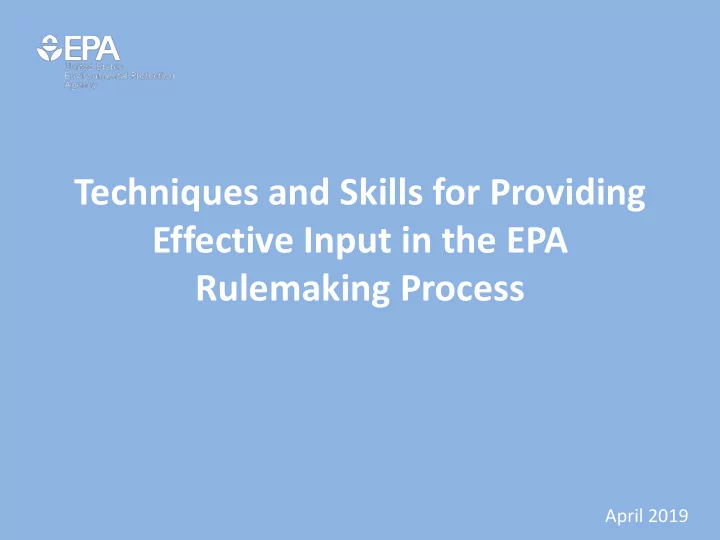

Techniques and Skills for Providing Effective Input in the EPA Rulemaking Process April 2019
Basics of the Regulatory Process • Congress passes the laws that govern the United States • Congress has also authorized EPA and other federal agencies to help put those laws into effect by creating and enforcing regulations • Regulations are mandatory requirements that can apply to individuals, businesses, state or local governments, non-profit institutions or others
EPA Regulations: Process For developing most regulations, EPA follows the same general process: • Step 1: EPA proposes a regulation, including specific periods for public input through both written comments and public hearings – Proposed regulation is published in the Federal Register • Step 2: EPA collects and considers comments from the public and issues a final rule • Step 3: Final regulation is published in the Federal Register, then is codified and added to the Code of Federal Regulations
Where to Find Information about Regulations • Reginfo.gov • FederalRegister.gov • Regulations.gov • GovInfo.gov
EPA Dockets https://www.epa.gov/dockets • Contain information that EPA uses in a rulemaking or other agency action and that explain or support its decisions • Contain public input provided through the formal comment process and in public hearings • Are available to the public for review
Making A Difference • Become familiar with the rulemaking process • Be involved early and often • Be prepared and organized • Be respectful • Be specific • Be constructive • Be realistic 6
PREPARING EFFECTIVE WRITTEN COMMENTS
Resources for Writing Comments https://www.epa.gov/laws- regulations/get-involved- epa-regulations https://www.regulations.go v/docs/Tips_For_Submitting _Effective_Comments.pdf https://www.oregon.gov/de q/FilterDocs/makeyourvoice heard.pdf 8
Getting Ready to Comment • Collect and review relevant materials • Get help understanding the issues • Identify your key issues and concerns 9
Review the Proposed Document • Read the preamble’s summary and table of contents – Determine which sections are most critical to you – Mark up document as you read it • Agreements • Disagreements • Questions • Concerns 10
Begin Your Assessment • Do you disagree with the underlying assumptions? • Is important information missing? • Do you agree with methodologies used in assessments, such as monitoring methodologies or risk assessments? • Do conclusions and recommendations appear to be logical and supported? • Be sure to document the reasons for your comments 11
Continuing Your Assessment • Check for consistency with other information – Check facts with other sources – Check cited references – Get feedback from allies/other experts 12
Tips • Make your comments easy to follow – Be organized – Be clear, concise and convincing – Support your key comments with evidence – Provide solutions – Submit comments by deadline 13
Organization and Format • Make it look professional • Clearly identify each section addressed • Use headings, indentation and bullets • Avoid dense blocks of text • If comments are lengthy consider a table of contents 14
Style • Use topic sentences • Use short sentences • Avoid passive voice • Write in the first person • Communicate honestly and with respect 15
Content • Identify legal shortcomings • Pinpoint factual mistakes • Suggest specific language • Highlight items you support and do not support • Provide examples • Offer alternative solutions 16
Before submitting • Check for accuracy and clarity • Proofread closely 17
PUBLIC HEARINGS
Preparing to Speak at a Public Hearing or Meeting • Read the preamble of the proposed rule and review other relevant documents • EPA’s proposed rules are accompanied by a fact sheet that summarizes key aspects of the proposal. These may help answer some of your questions. 19
Developing Your Comments • Make your comments in 3 to 5 minutes – Focus on questions that EPA outlines in the preamble – Determine what your key messages will be – Be factual – Make specific recommendations – Be clear, concise and constructive – Practice, practice, practice 20
Speaking at a Public Hearing or Meeting • Respect the time limits • Speak clearly and confidently • Follow up with written comments 21
Image Sources (Slide number references shown in parentheses) • Public meeting (17): U.S. EPA • Public meeting (20): U.S. EPA 22
Recommend
More recommend